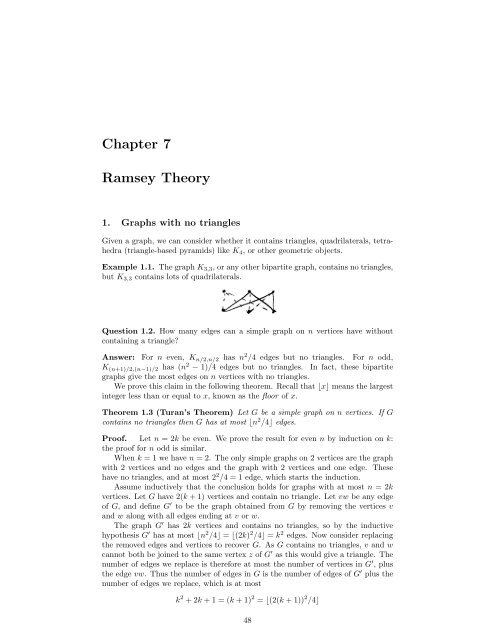Create successful ePaper yourself
Turn your PDF publications into a flip-book with our unique Google optimized e-Paper software.
Chapter 7Ramsey <strong>Theory</strong>1. <strong>Graph</strong>s with no trianglesGiven a graph, we can consider whether it contains triangles, quadrilaterals, tetrahedra(triangle-based pyramids) like K 4 , or other geometric objects.Example 1.1. The graph K 3,3 , or any other bipartite graph, contains no triangles,but K 3,3 contains lots of quadrilaterals.Question 1.2. How many edges can a simple graph on n vertices have withoutcontaining a triangle?Answer: For n even, K n/2,n/2 has n 2 /4 edges but no triangles. For n odd,K (n+1)/2,(n−1)/2 has (n 2 − 1)/4 edges but no triangles. In fact, these bipartitegraphs give the most edges on n vertices with no triangles.We prove this claim in the following theorem. Recall that ⌊x⌋ means the largestinteger less than or equal to x, known as the floor of x.Theorem 1.3 (Turan’s Theorem) Let G be a simple graph on n vertices. If Gcontains no triangles then G has at most ⌊n 2 /4⌋ edges.Proof. Let n = 2k be even. We prove the result for even n by induction on k:the proof for n odd is similar.When k = 1 we have n = 2. The only simple graphs on 2 vertices are the graphwith 2 vertices and no edges and the graph with 2 vertices and one edge. Thesehave no triangles, and at most 2 2 /4 = 1 edge, which starts the induction.Assume inductively that the conclusion holds for graphs with at most n = 2kvertices. Let G have 2(k + 1) vertices and contain no triangle. Let vw be any edgeof G, and define G ′ to be the graph obtained from G by removing the vertices vand w along with all edges ending at v or w.The graph G ′ has 2k vertices and contains no triangles, so by the inductivehypothesis G ′ has at most ⌊n 2 /4⌋ = ⌊(2k) 2 /4⌋ = k 2 edges. Now consider replacingthe removed edges and vertices to recover G. As G contains no triangles, v and wcannot both be joined to the same vertex z of G ′ as this would give a triangle. Thenumber of edges we replace is therefore at most the number of vertices in G ′ , plusthe edge vw. Thus the number of edges in G is the number of edges of G ′ plus thenumber of edges we replace, which is at mostk 2 + 2k + 1 = (k + 1) 2 = ⌊(2(k + 1)) 2 /4⌋48













